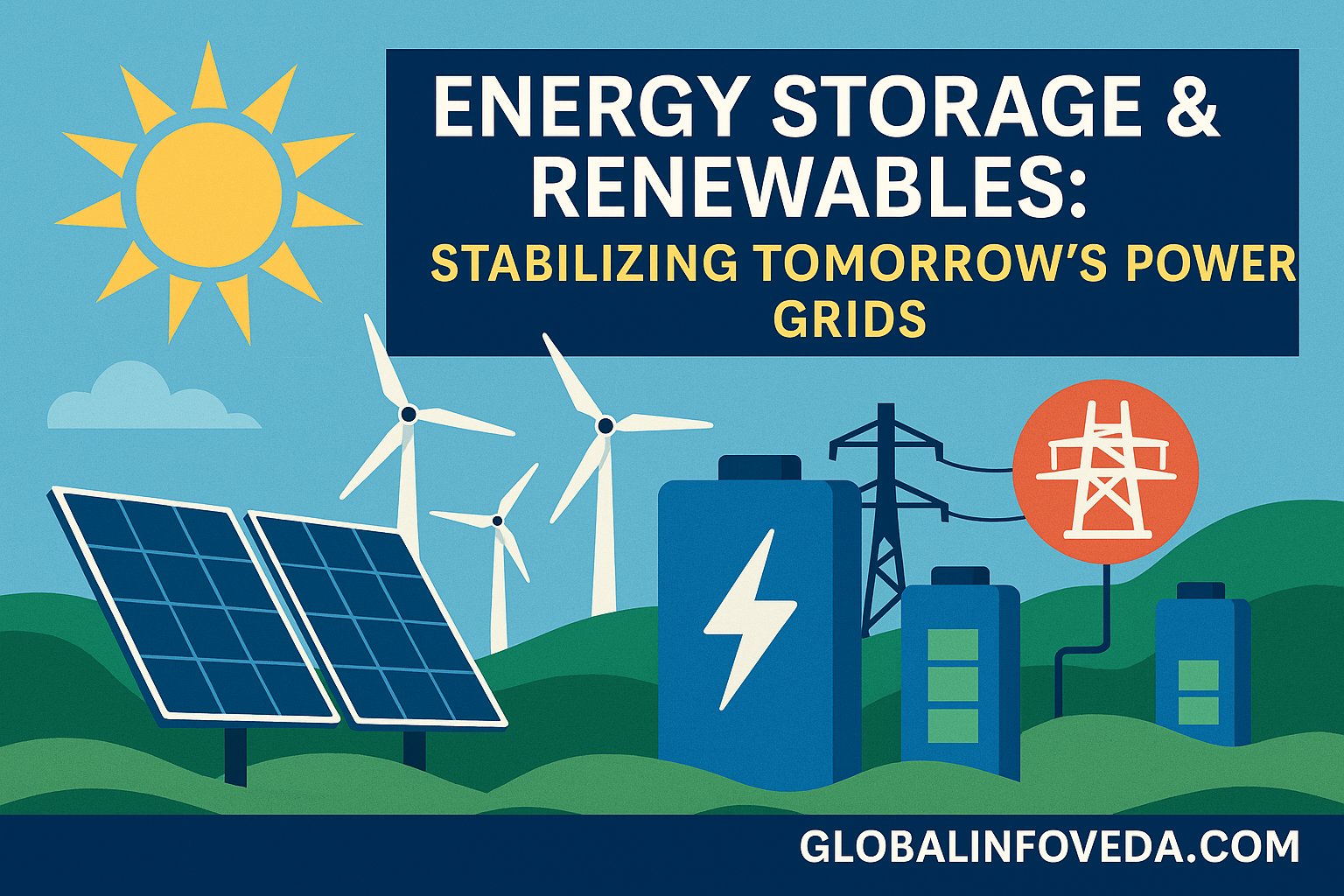Energy Storage & Renewables: Stabilizing Tomorrow’s Power Grids
🌱 Introduction: Powering a Stable Renewable Future
The global shift toward renewable energy is entering a pivotal stage. While solar, wind, hydro, and other renewables are expanding at record speed, their inherent variability challenges the stability of traditional grids. Cloudy days, windless nights, and seasonal fluctuations can all cause sharp dips in renewable power supply—exactly when demand may be peaking.
Energy storage technologies—ranging from lithium-ion battery farms and advanced flow batteries to pumped hydro and compressed air systems—are becoming the grid’s stabilizers. They store excess power during peak production and release it during shortages, providing the constant, predictable energy supply needed to keep homes, businesses, and industries running without interruption.
These systems are more than just technical solutions—they are critical enablers of energy independence, climate resilience, and economic transformation. For more on transformative tech, read How Quantum Computing Will Change Everything by 2030.
📊 Big Picture: Why Energy Storage Matters
- ⚡ Grid Stability: Prevents blackouts and voltage fluctuations by balancing supply-demand in real time.
- ☀️ Renewable Integration: Converts intermittent renewable output into dependable baseload supply.
- 🇮🇳 Energy Independence: Cuts fossil fuel imports, safeguarding against geopolitical energy shocks.
- 💼 Economic Opportunity: Creates manufacturing, installation, and maintenance jobs.
- 🛡️ Resilience: Acts as a safety net during disasters, cyberattacks, or infrastructure failures.
For emerging breakthroughs in battery technology, check Solid-State Batteries: The Breakthrough Tech Powering EVs in 2025.
🔍 The Sectors Powering the Change
1. Utility-Scale Storage
- Battery Farms: Large installations capable of storing gigawatt-hours for entire regions.
- Pumped Hydro: Uses off-peak energy to pump water uphill, releasing it through turbines when demand spikes.
- Hybrid Systems: Combining solar, wind, and storage to create fully renewable microgrids.
2. Residential & Commercial Systems
- Rooftop solar linked to battery packs for self-sufficiency.
- Protection against outages and dynamic pricing benefits.
- Smart home integration with IoT to optimize energy usage.
3. Industrial & Transportation Applications
- High-capacity storage at EV charging hubs.
- Backup for data centers, hospitals, and defense facilities.
- Energy support for large-scale electrified rail and port operations.
For parallels in tech-driven infrastructure upgrades, read Made-in-India Defence Tech: What DRDO and Startups Are Building in 2025.
📈 Economic Impact Analysis
- Cost Reduction: Lithium-ion battery prices have fallen from over $1,200/kWh in 2010 to under $150/kWh today.
- Market Expansion: Global storage capacity is forecasted to reach over 1,000 GW by 2030.
- Investor Momentum: Governments and private investors are pouring billions into storage R&D.
- Consumer Gains: Households can save 20–30% on annual electricity bills through time-of-use optimization.
For policy-driven market changes, see GST Reform 2025: What the Tax Changes Mean for Your Wallet.
📜 Historical Context
- 1920s–1950s: Pumped hydro storage developed for large-scale load balancing.
- 1990s: Lithium-ion technology revolutionizes electronics, paving the way for renewable integration.
- 2020s: Global push for long-duration storage solutions, including gravity storage and hydrogen-based systems.
📊 Comparison Chart: Energy Storage Technologies
| Technology | Efficiency | Lifespan | Cost Trend | Best Use Case |
|---|---|---|---|---|
| Lithium-ion | 85-95% | 10-15 yrs | Falling | EVs, homes, commercial storage |
| Flow Batteries | 65-85% | 20+ yrs | Stable | Long-duration, utility storage |
| Pumped Hydro | 70-80% | 40+ yrs | Stable | Large-scale baseload management |
| Compressed Air | 50-70% | 25+ yrs | Stable | Industrial energy buffering |
For an innovation deep dive, check AI vs Human Intelligence: Can Machines Ever Replace Us?.
🏛️ Policy & Relief Measures
- Financial Incentives: Tax credits, subsidies, and grants for storage systems.
- Mandates: Targets for utilities to include a percentage of storage in their energy mix.
- Green Bonds: Financing storage projects through climate-focused investment vehicles.
- Decentralized Energy Policies: Promoting community-owned microgrids.
🌍 Cultural & Economic Implications
- Green Jobs: From mining and manufacturing to recycling lithium and rare earths.
- Sustainability Impact: Cuts millions of tons of CO₂ annually.
- Rural Electrification: Brings stable electricity to villages, boosting education and economic activity.
- Disaster Readiness: Ensures critical infrastructure like hospitals and emergency services stay operational.
For home sustainability tips, read How to Grow Organic Vegetables at Home (Step-by-Step).
💡 Final Insight: The Backbone of Tomorrow’s Grid
Energy storage is no longer optional—it’s the cornerstone of a renewable-powered civilization. Nations that lead in diverse, scalable storage systems will define the energy landscape of the 21st century.
For broader global trend insights, see Global Affairs 2025: The Five Trends Reshaping Our World.
📡 Read more at GlobalInfoVeda.com
